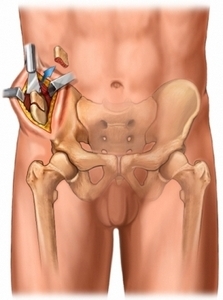Bone graft
Description bone graft
During bone grafting, part of the donor bone is added to the site of fracture or other bone defects. The new bone can stimulate bone growth, bridge the gap bone, provide support and assistance in recovery.
New bone can be taken from the other body part (graft) or from another human (allograft). Rarely used synthetic prosthesis, are not bone.
Reasons to Install a bone graft
Your doctor may recommend a bone graft in the following cases:
- Treatment of fractures, that do not heal in the usual way;
- For the reconstruction of the destroyed bone;
- Fill gaps in bone, caused by a cyst or tumor;
- It is necessary to stimulate bone growth, to fix the artificial joint or other implant.
Possible complications during the installation of bone graft
Complications are rare, but that does not mean the absolute absence of risk. If you plan to perform a transplant of bone, the doctor will review the possible complications, which may include:
- Bleeding;
- Infection;
- The appearance of blood clots;
- Nerve Damage;
- Transplant rejection by another person (Donor);
- Fat particles fall into the bone marrow and then into the lung (rarely);
- Reaction to anesthesia.
Factors, that may increase the risk of complications:
- Long-term illness;
- Advanced age;
- Smoking.
How is the installation of a bone graft?
Preparing for the Transplant
Doctor, probably, perform these steps::
- Conduct a physical inspection;
- Appoint an X-ray bone graft at the installation site.
Preparation for the procedure
- The patient may be asked to stop taking some medicines (including herbal supplements) one week before the procedure,:
- Aspirin or other anti-inflammatory drugs;
- Blood thinners, such as clopidogrel (Plaviks) or warfarin;
- Do not eat or drink after midnight the day before surgery, unless otherwise noted physician;
- We must organize care at home after returning from the hospital.
Anesthesia
There are two variants of anesthesia:
- Local anesthesia is necessary numb areas of the body. During the procedure, the patient will be awake;
- General anesthesia – the patient will sleep during the installation of bone graft.
Installation procedures bone graft
The method of treatment depends on the type and location of the fault or defect, and the bone graft type, which will be installed.
Most installation procedures using bone graft bone site of the operated. The bone is often taken from the iliac crest. It – hip bone, approximately at the location, where the belt is worn.
Some of the bones, which will be used as the graft is cut special tool. Then a special chisel poluklinoobraznym it is removed. Section zashivaetsya.
Next, the doctor will cut the skin, covering the area of installation of the graft. All those extra parts or dead tissue from the installation of the graft will be removed. Then, bone graft is mounted on refined place. Doctor, perhaps, should immobilize the bone. During this procedure can be used plates and screws, to immobilize the bone. After the procedure may be necessary bandage or plaster immobilization.
After the installation process bone graft
X-rays can be made, To make sure, that the bone in the correct position.
How long will the installation of bone graft?
The length of the operation will depend on its complexity.
How much will it hurt?
Anesthesia prevents pain during the procedure. Analgesics reduce discomfort during recovery.
The average hospital stay after the installation of bone graft
Hospital stays, It will depend on the complexity of the operation and speed of recovery
Postoperative care
Care depends on the procedure and the location of a bone graft:
- It is necessary to follow the doctor's instructions when taking a shower and dressing;
- It is not recommended to smoke. Smoking can delay bone healing;
- Some operations Installation transplant may be unsuccessful. The doctor will monitor the progress of X-rays;
- Be sure to follow your doctor's instructions.
Hazardous situations, after the installation of bone graft
After discharge from the hospital need to see a doctor in the following cases:
- There are signs of infection, including fever and chills;
- Redness, edema, increased pain, bleeding, or any discharge from the incision;
- Nausea and / or vomiting, which do not disappear after taking the prescribed medicines, and persist for more than two days after discharge from the hospital;
- Pain, that does not go after the adoption of the designated anesthetics;
- Pain, burning, frequent urination or persistent blood in the urine;
- Cough, shortness of breath or chest pain;
- Numbness or tingling at the site of surgery.
In the case of a serious and rapidly deteriorating health should immediately call an ambulance.

